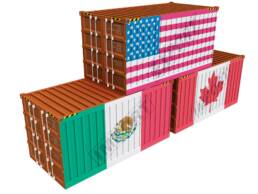On Sunday night, after more than a year of intense negotiations, the United States, Canada and Mexico reached an agreement to update the North American Free Trade Agreement (NAFTA), the 1994 pact that governs more than $1.2 trillion worth of trade among the three nations. The new deal won’t go into effect until 2020, as leaders from the three countries need to sign it and it then needs to go through Congress and the legislatures in Canada and Mexico. The new deal will be known as the United States-Mexico-Canada Agreement or USMCA.
Here are some of the main points of the new agreement:
Cars
The goal of the new deal is to have more cars and truck parts made in North America. Beginning in 2020, to qualify for zero tariffs, a car or truck must have 75% of its components manufactured in Canada, Mexico or the United States, a substantial boost from the current 62.5% requirements. There’s also a new rule that a significant percentage of the work done on the car must be completed by workers earning at least $16 an hour, or about three times what the typical Mexican autoworker makes. Starting in 2020, cars and trucks should have at least 30% of the work on the vehicle done by workers earning $16 an hour. That gradually moves up to 40% for cars by 2023.
Dairy
Trump made it very clear that he thought it unfair that Canada charged such high tariffs on U.S. dairy products. Canada has a complex milk and dairy system. To ensure Canadian dairy farmers don’t go bankrupt, the Canadian government restricts how much dairy can be produced in the country and how much foreign dairy can enter to keep milk prices high. This was a major sticking point in the negotiations. Ultimately, Canada will keep most of its complex system in place, but it is giving greater market share to U.S. dairy farmers. Canada will eliminate the pricing scheme for what are known as Class 7 dairy products. That means U.S. dairy farmers can probably send a lot more milk protein concentrate, skim milk powder and infant formula to Canada.
Chapter 19 – Special Dispute Process
Canada’s Prime Minister Justin Trudeau repeatedly stated that he wanted to keep Chapter 19 in place and he got his wish. The U.S. pushed hard to eliminate this chapter, but it ultimately remains. Chapter 19 allows Canada, Mexico and the U.S. to challenge each other’s anti-dumping and countervailing duties in front of a panel of representatives from each country. This is generally a much easier process than trying to challenge a trade practice in U.S. court.
Auto Tariffs
Trump has repeatedly threatened to slap hefty tariffs on car and vehicle parts coming from overseas into the United States. Along with a new trade deal, his administration signed “side letters” allowing the two nations to mostly dodge these auto tariffs. The side letters say that Canada and Mexico can continue sending about the same number of vehicles and parts across the border free of charge, regardless of whether auto tariffs go into effect down the road. Only parts above a certain quota could face tariffs.
Steel Tariffs
Canada wanted Trump to stop his 25% tariffs on Canadian steel, which hasn’t happened yet. The two countries are still discussing lifting those tariffs, but a senior White House Official said Sunday that process is on a “completely separate track.” Trudeau has called the steel tariffs “insulting and unacceptable” because the two nations are such close allies.
Improved Labor and Environmental Rights
The USMCA makes a number of significant upgrades to environmental and labor regulations, especially regarding Mexico. For example, the USMCA stipulates that Mexican trucks that cross the border into the U.S. must meet higher safety regulations and that Mexican workers must have more ability to organize and form unions. Some of these provisions might be difficult to enforce, but the Trump administration says it is committed to ensuring these happen.
Increased Intellectual Property Protections
The new Intellectual Property chapter is 63 pages and contains more stringent protections for patents and trademarks, including for biotech, financial services and even domain names. Many business leaders and legal experts believed these updates were necessary given that the original agreement was negotiated 25 years ago.
Chapter 11 – Giving Investors a Special Way to Fight Government Decisions is Mostly Gone
Chapter 11 is eliminated entirely for Canada and mostly for Mexico, except for some key industries such as energy and telecommunications. Chapter 11 gave companies and investors a special process to resolve disputes with one of the governments in NAFTA. The idea was that if investors put a lot of money into a project and then the government changed the rules, there was a clear dispute process – outside the court system – where investors could get their problem resolved. In the end, Chapter 11 is mostly gone, except for a few key industries such as oil, that lobbied hard to be able to challenge the Mexican government if it changes the rules and tries to nationalize its energy sector again.
Immigration
The impact on immigration between the countries is still to be determined. Reports leading up to last night’s agreement have indicated the Trump administration was working to slash the number of visas granted to Canadian and Mexican professionals under the new deal.
Berardi Immigration Law will continue to closely monitor this and will update our clients with the latest information. Be sure to check back for more immigration breaking news!
Related Posts
October 15, 2025
Success Story: A Canadian Consulting Firm’s E-2 Visa
September 29, 2025
Project Firewall: What Employers and H-1B Workers Need to Know
Ready to have Berardi on your side?
Whether you’re a business looking to hire or a professional hoping to relocate, immigration law can be complicated. But you don’t have to do it alone. Put our experience to work for you.



